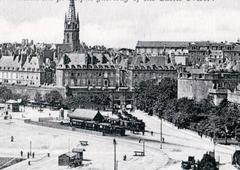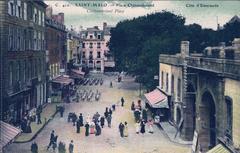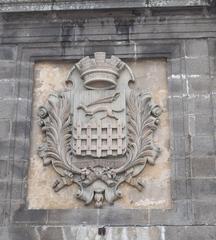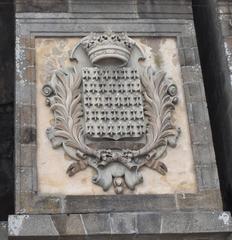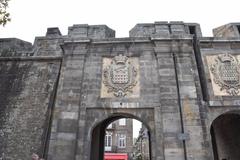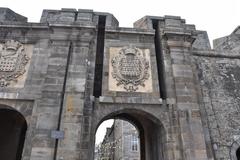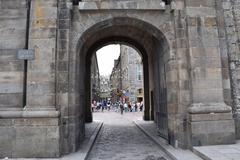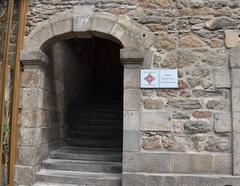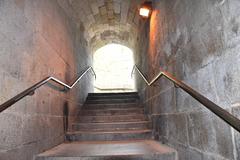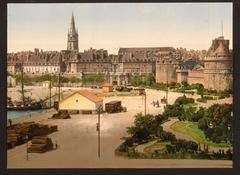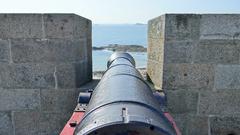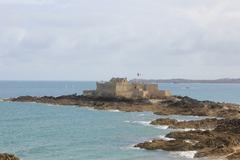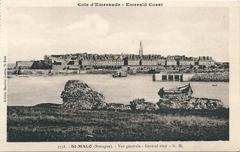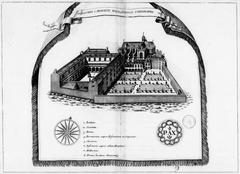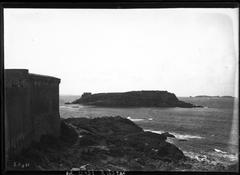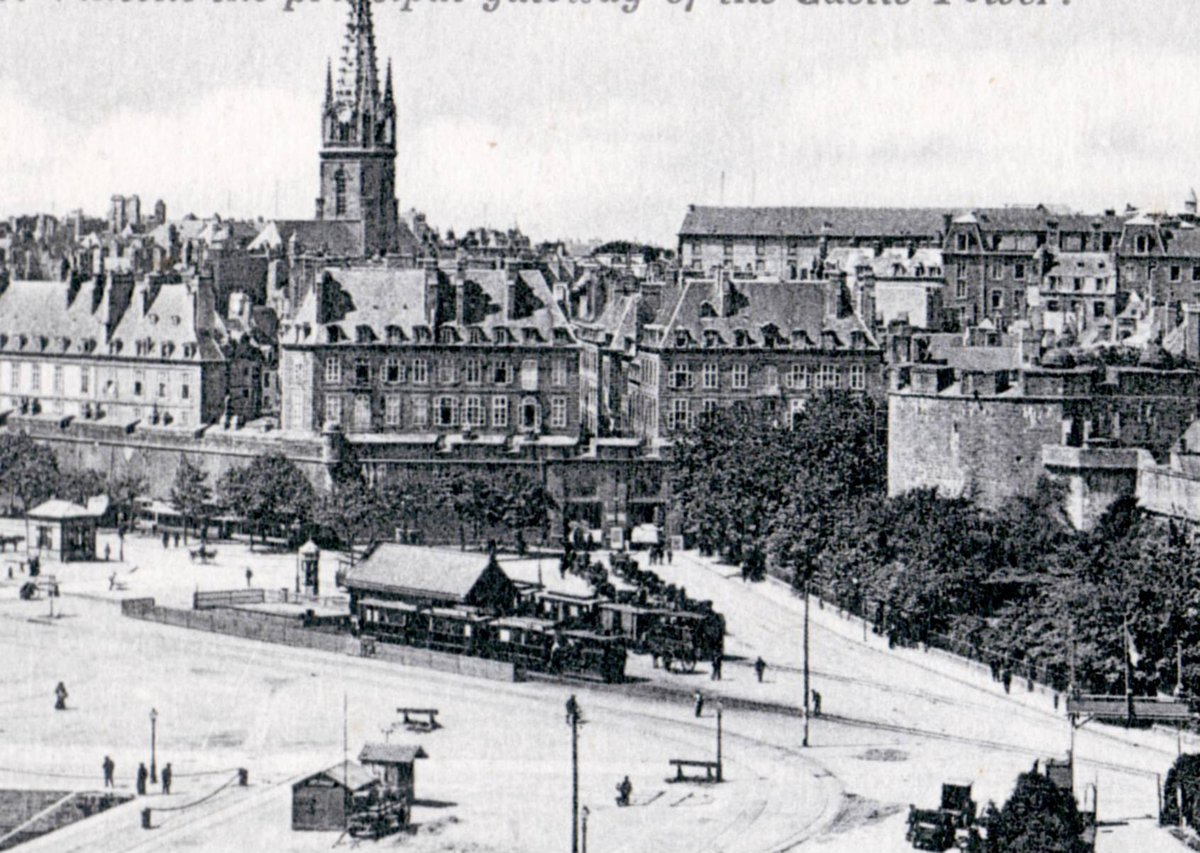
Porte Saint-Vincent, Saint-Malo: Visiting Hours, Tickets, and Travel Guide
Date: 14/06/2025
Introduction
Porte Saint-Vincent stands as the emblematic entrance to Saint-Malo’s historic walled city, or Intra-Muros, along the northern coast of Brittany, France. This gateway isn’t just a physical threshold—it’s an invitation to experience centuries of maritime adventure, fortress architecture, and vibrant Breton culture. In this detailed guide, you’ll find essential information on visiting hours, ticketing, accessibility, highlights, and nearby attractions, plus travel tips for making the most of your Saint-Malo visit (Saint-Malo Tourisme, The Good Life France, Nomads Travel Guide).
Table of Contents
- Introduction
- Historical Context and Cultural Significance
- Architectural Features and Urban Integration
- Visiting Hours, Tickets, and Accessibility
- Getting There: Directions & Transport
- Highlights and Nearby Attractions
- Events, Gastronomy, and Local Life
- Practical Visitor Tips
- Frequently Asked Questions (FAQ)
- Conclusion and Recommendations
- References
Historical Context and Cultural Significance
Origins and Evolution
Porte Saint-Vincent was constructed between 1708 and 1710 to serve as the main entrance into Saint-Malo’s fortified city. Named for Saint Vincent of Saragossa, the city’s patron saint, the gate reflects both religious and civic pride. Built of resilient local granite and adorned with the coats of arms of Saint-Malo and Brittany, it was the principal access point for traders, sailors, and visitors arriving by land or sea (Saint Malo Secret).
Saint-Malo’s heritage as a corsair stronghold and independent republic is deeply embedded in the symbolism of the gate. In 1590, the city famously declared, “Ni français, ni breton, Malouin suis!” (“Neither French nor Breton, I am Malouin!”), underscoring its fiercely autonomous spirit (OT Mont Saint-Michel).
Wartime Resilience
The ramparts and gates, including Porte Saint-Vincent, have withstood centuries of conflict. World War II brought devastating destruction to Saint-Malo, with nearly 80% of the intra-muros razed. However, careful post-war restoration ensured the survival and authenticity of Porte Saint-Vincent and its surrounding walls (Saint-Malo Tourisme PDF).
Architectural Features and Urban Integration
Porte Saint-Vincent exemplifies early modern military architecture—solid, imposing, and richly symbolic. The granite archway, flanked by two towers, bears ornate coats of arms: one for Saint-Malo (with the ermine, a Breton symbol) and one for the Duchy of Brittany. These details highlight the city’s regional identity and proud history (Nomads Travel Guide).
The gate opens onto the bustling Place Chateaubriand, a lively square lined with restaurants and hotels. From here, Rue Saint-Vincent leads deeper into the old town, while the nearby ramparts offer panoramic views of the port, sea, and city skyline (monsieur-de-france.com).
Visiting Hours, Tickets, and Accessibility
- Porte Saint-Vincent: Open 24/7, year-round. No entrance fee.
- Ramparts: Also freely accessible; best experienced during daylight.
- Nearby Attractions: Certain museums (like Château de Saint-Malo) and guided tours require tickets; check individual sites or the Saint-Malo Tourist Office for details.
Accessibility: The gate and Place Chateaubriand are wheelchair accessible. Note that cobblestones and some ramparts sections may be challenging for those with mobility issues, but assistance and accessible routes are available (Wikitravel).
Getting There: Directions & Transport
- By Train: Saint-Malo station is 1.5 km from the gate—a 20-minute walk or short bus/taxi ride.
- By Car: Intra-Muros is pedestrian-only; use nearby paid lots like Parking Saint-Vincent or Parking Quai Saint-Louis (thewalkingparrot.com).
- By Bus: Local buses connect the station, ferry terminal, and stops near the gate. Tickets are available as single rides or day passes.
- By Ferry: The ferry terminal (serving the UK, Channel Islands, and Dinard) is a 10–15 minute walk from Porte Saint-Vincent.
Highlights and Nearby Attractions
Place Chateaubriand
Immediately inside the gate, this vibrant square is a hub of activity, dining, and cultural events. It’s named for François-René de Chateaubriand, the Romantic writer and Saint-Malo native (Railtour).
Château de Saint-Malo
This 15th-century fortress, now housing the city hall and museum, offers exhibitions on Saint-Malo’s maritime history and sweeping views from its tower (The Crazy Tourist).
Remparts de Saint-Malo
Walk the 1.7 km circuit of ramparts for panoramic vistas of the sea, tidal islands, and city rooftops (saintmalowithlove.com).
Cathédrale Saint-Vincent
A blend of Romanesque and Gothic styles, this cathedral is both a spiritual and historic focal point. It houses the tomb of Jacques Cartier, the explorer who claimed Canada for France (Carnets Vanille).
Plage du Sillon
A sweeping sandy beach just outside the walls, ideal for scenic walks and sea views.
Grand Bé and Petit Bé
Tidal islands accessible on foot at low tide—Grand Bé contains Chateaubriand’s tomb, while Petit Bé features historic fortifications (Saint Malo Secret).
Events, Gastronomy, and Local Life
The area around Porte Saint-Vincent brims with restaurants, crêperies, and cafés serving Breton specialties—don’t miss the salted butter caramels, galettes, and local cider (Wikitravel). The city hosts events like the Route du Rhum (transatlantic yacht race), La Route du Rock music festival, and the Etonnants Voyageurs literary festival, many of which center on the esplanade and port (Carnets Vanille).
Practical Visitor Tips
- Tourist Office: Just outside the gate for maps, event info, and tide schedules.
- Best Times to Visit: Spring and early autumn offer pleasant weather and fewer crowds.
- Walking Tips: Wear sturdy shoes for cobblestones and be aware of tides if visiting the islands.
- Language: French is primary, but English is widely spoken in tourist areas.
- Accommodation: Book ahead during high season; options range from budget hostels to luxury hotels within the walls.
Frequently Asked Questions (FAQ)
Q: What are the opening hours of Porte Saint-Vincent?
A: The gate is accessible 24/7, year-round, with no entrance fee.
Q: Is the site accessible for wheelchair users?
A: Yes, the gate and main squares are accessible, though some ramparts and cobblestone streets may be challenging.
Q: Are guided tours available?
A: Yes, walking tours and tourist trains depart from near the gate, especially from April to October (Wikitravel).
Q: Where can I park?
A: Use paid lots like Parking Saint-Vincent or Parking Quai Saint-Louis; parking inside Intra-Muros is not permitted (monsieur-de-france.com).
Conclusion and Recommendations
Porte Saint-Vincent is much more than a city gate—it is your entry to the history, culture, and dynamic life of Saint-Malo. Open day and night and free to enter, it offers easy access to the ramparts, lively squares, and a host of historic attractions. Whether you’re a history buff, foodie, or festival-goer, Porte Saint-Vincent is an essential stop for every visitor to Brittany.
Travel Tip: For the latest updates, maps, and guided audio tours, download the Audiala app and visit the Saint-Malo Tourist Office. Book accommodation early during festivals and check tide times if planning to explore the tidal islands.
References
- Saint-Malo Tourisme
- The Good Life France
- monsieur-de-france.com
- Saint Malo Secret
- Nomads Travel Guide
- The Crazy Tourist
- Saint-Malo Tourisme PDF
- OT Mont Saint-Michel
- Wikitravel
- Carnets Vanille
- saintmalowithlove.com
